|
SOMME 100
THE NATIONAL AND INTERNATIONAL COMMEMORATIONS
by Lieutenant Colonel D M Hannah MBE
Irish Guards
|
One hundred years on, the Battle of the Somme remains seared into our national consciousness. For the people of Britain and of the Commonwealth, it was unlike any battle that had preceded it and arguably, unlike any subsequent battle, not least in terms of its impact, the controversy it provokes and the complex range of associations it evokes.
It was a battle that saw the development of new technologies, from combat aircraft to tanks (the first of which were deployed on the Somme in September 1916) that would later become an integral part of modern warfare.

Somme 100, Thiepval, 1st July 2016.
The Guard of Honour. 1st Battalion Irish Guards.
The Subaltern, Captain Ed Foggin is in the foreground
|
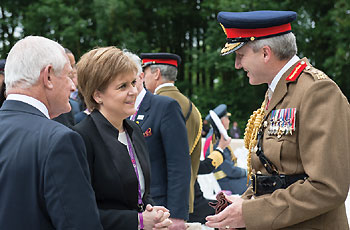
Nicola Sturgeon, First Minister of Scotland, with the Major General |
The scale of the operation was only possible thanks to the extraordinary popular mobilisation exercise launched by Lord Kitchener, the Secretary of State for War, in the autumn of 1914, intended to redress the manpower imbalance of the miniscule British Army in relation to the million strong armed multitudes that conscription allowed other European powers to deploy into the field. Driven by a variety of motives, some of which might appear naïve or even quaint in the light of retrospective 21st century cynicism, from pure patriotism, to the thrill of adventure to a remarkably widespread sense of duty, transcending traditional boundaries of class, creed or colour, almost 2.5 million men had joined up in Britain and Ireland by the end of 1915. Many chose to join battalions formed of volunteers from the same communities, clubs, schools and workplaces. These became known as the ‘Pals Battalions’. Some would fight as part of existing army divisions, others formed New Army Divisions, bolstered by more experienced remnants of the original British Expeditionary Force. By the summer of 1916, the British Army could muster over one million men on the Western Front, incorporating troops from across the British Empire. It was arguably the largest, best educated, and healthiest volunteer army that Britain had ever fielded, with cheerfully confident high morale, high hopes - and equally high expectations of rapid and decisive success.
It was perhaps the harsh dashing of these collective hopes and expectations, especially with the scale of the losses (a million casualties on all sides) and most especially those suffered by the British on the first day of the battle (over 57,400, of whom almost 20,000 were killed or missing), with all that such figures imply, for the soldiers, their immediate families and their wider communities, that explains why the Battle of the Somme continues to have a particular resonance one hundred years on.
The strategic context of the battle was one of allied frustration at their collective inability to restore the war of manoeuvre, despite the relative success of the Battle of the Marne in blunting the swift and almost successful Schlieffen plan to capture Paris. Following the ‘race to the sea’ and the subsequent solidifying of respective trench lines from Nieuport on the Belgian North Sea coast to the Swiss border, Allied plans made at the French Army HQ at Chantilly in late 1915 envisaged a series of coordinated attacks on all fronts, throughout 1916, designed to inflict attrition and to thwart German reinforcement and counter-attack capacity. These well-crafted plans were undermined by the German High Command’s decision to strike first, at Verdun, thereby fixing much of the available French resources and presenting an over-riding imperative for the British Army to shoulder the bulk of the burden of the planned summer offensive, not least, to reduce the pressure on the French on the hitherto relatively quiet sector of the Somme River, where the British and French lines joined. It was here, across the rugged land of rivers, tributaries and streams, steep banks and commanding ridgelines, that British, French, Commonwealth and German troops fought for 141 days, in all extremes of weather and the most arduous of conditions.
Planning for the Somme 100 Commemorations began over four years ago when Prime Minister David Cameron directed that the Department for Culture, Media and Sport (DCMS) should lead and coordinate all British national/bi-national and international World War One Centenary Commemorations, following an agreed programme which focused on a series of key events. So far, these have included marking the Retreat from Mons in 1914, the Gallipoli landings in 1915 and, most recently, the centenary the Battle of Jutland (marked in May) and the eve of and the first day of the Battle of the Somme on 1st July.
The appetite to commemorate the Somme Centenary was widespread and while regiments and associations were encouraged to go ahead with respective events, there were three official national events: a Vigil at Westminster Abbey to mark the eve of the first day of the battle on 30th June, attended by Her Majesty The Queen and The Duke of Edinburgh, followed by a parade the following day, in Manchester, from where so many of the ‘Pals Battalions’ originated, with the salute taken by The Duke of York. The main official international commemoration was hosted bi-nationally with France at the Thiepval Memorial to the Missing of the Somme.
The scale of the latter was deemed to be commensurate with the importance of the anniversary, with an overnight Vigil, some 10,000 invited guests, two large Guards of Honour provided by the 1st Battalion Irish Guards and St Cyr L’Ecole (the French equivalent of RMAS), two military bands, the BBC Symphony Orchestra, two choirs, artillery salutes from both The King’s Troop Royal Horse Artillery (in Service Dress, similar to the uniform worn in 1916) and their French Artillery equivalent. This was to be followed by a Service of Commemoration and Wreath Laying by The Prince of Wales, supported by The Duke of Cambridge, the Duchess of Cornwall, the Duchess of Cambridge, Prince Henry of Wales and The Duke and Duchess of Gloucester.
Representing the bi-national dimension was to be François Hollande, President of the French Republic (though this was very much in doubt due to EU Referendum sensitivities and was only confirmed at the eleventh hour); representing Ireland was President Michael Higgins and the Federal Republic of Germany was represented by former President, Professor Dr Horst Kohler. Canada was represented by the Veterans Minister; other nations, including Australia, New Zealand, South Africa and India, were also formally represented.
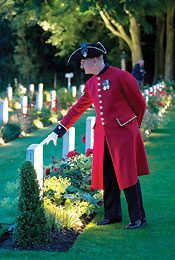
A Chelsea Pensioner
Thiepval. 1st July 2016
|
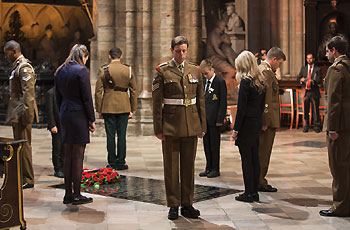
The Somme Vigil at Westminster Abbey. 30th June 2016 |
Thiepval, Edwin Lutyens’ monumental masterpiece, is dedicated to the 72,000 ‘Missing of the Somme’, (specifically listing the names of the British and South African missing in the Somme Sector between July 1915 and March 1918; Australian, Newfoundland, New Zealand, Indian and Canadian missing are commemorated on other national monuments on the battlefield. The youngest soldier listed was a mere 15 years old; the oldest, 59. None has a known grave, so this memorial, with their names inscribed, is designed to ensure that their names will live on in perpetuity. The Thiepval monument, standing 45 metres high, overlooking much of the battlefield, is built on the site of the Schwaben Redoubt, a key strongpoint in the German line and one of the objectives of the original assault on the first day of the Somme battle. In 1932, its completion was marked with great ceremony by Edward, Prince of Wales (who had served with the Grenadier Guards in the war). Also present was Major General Fabian Ware whose foresight, inspiration and drive were instrumental to the establishment of the Imperial (now Commonwealth) War Graves Commission, without which the memory of the sacrifice and legacy of those who died in the First World War might well have been lost by now. Originally raised in the bleak, devastated post war landscape, the Somme Memorial is now surrounded by mature trees, lush meadows and green, fertile farmland providing tangible evidence of a degree of restoration and regeneration that survivors of this battle would find hard to believe.
HRH The Duke of Kent, President of the Commonwealth War Graves Commission, has written:
‘Our memorial mirrors the Somme Offensive itself, which was fought on a human and industrial scale unparalleled at the time. But unlike that fierce struggle a century ago, this monument is a creative force - a physical expression of our determination to never forget what took place here. The alliances and friendships forged both individual and national, the heroism, destruction and, of course, losses were on an unprecedented scale, which was felt across the British Isles and our Commonwealth. Today, the landscape around us is peaceful. Alongside rebuilt farms and villages are tens of thousands of war graves in cemeteries of which the Commission remains a proud custodian. In the shadow of this great monument lie soldiers of France and the Commonwealth, side by side, symbolic of a common purpose and a common sacrifice. Today, tomorrow, and for as long as stone stands on stone, we will always remember them’.
Lutyens’ Monument provided not only the focus of this year’s centenary commemoration on 1st July, but also the site for the Evensong Service the evening before, overlooking the graves which were lit from behind each gravestone and cross, and from which personal accounts, written by soldiers before and after the battle, were read by some of their modern counterparts, all wearing Service Dress which has not changed significantly in the hundred years since the Somme, and mostly wearing more recent campaign medals, a reminder that the tradition of duty and service to Queen and Country remains a proud duty of the Somme’s successors. The Monument also served as a backdrop to the screening of the Imperial War Museum’s 1916 film of the battle, screened before the service as the 10,000 spectators took their seats. From the steps of the Monument, a series of carefully selected accounts was read, describing key aspects of the battle but capturing a human dimension that was both evocative and deeply poignant.
Narrators included the actor Charles Dance and the actress Joely Richardson. Readers ranged from Sol Campbell, a former England team member, recounting the fate of Leyton Orient’s star player, Pte William Jonas, to the Prime Minister, reading about an episode when common humanity prevailed during the heat of battle, with the German troops spontaneously holding their fire while a British officer climbed from his trench to rescue one of his men who was hanging wounded on the German barbed wire. Deeply memorable was the account by Lieutenant Tom Adlam VC, 7th Battalion, Bedfordshire Regiment, of overcoming one’s sense of fear because ‘you’ve got a group of men with you, you’re in charge of them. We were taught to be an example to our men and that if we went forward, they’d go with you, you see. And you sort of lose your sense of fear, thinking about other people’. This was movingly read by his son, providing a direct link with the past, noting that his father’s VC was won in action that took place just a few hundred metres from where the Monument stands today. Similarly, a letter written by the grieving widow of Second Lieutenant Harold Scarlett of the London Regiment, was read by their granddaughter, providing a telling reminder of how keenly and painfully the impact of the battle was felt on the Home Front - and how remarkable was so often the dignity and stoicism shown, despite the grief.
The readings were interspersed with music which ranged from Keep the Home Fires Burning, sung by the Morriston Orpheus Choir, accompanied by the Band of the Welsh Guards, to La Madelon, performed by the Choeur de l’Armée Francaise.
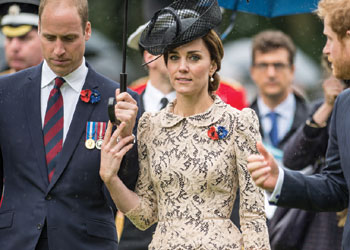
The Duke and Duchess of Cambridge and Prince Harry
Thiepval. 1st July 2016
|
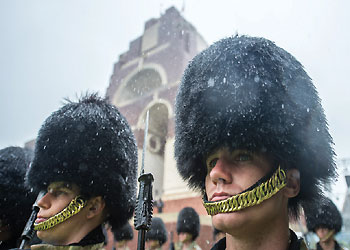
The Guard of Honour at a very wet rehearsal at Thiepval prior to the main event on 1st July 2016 |
The final reading was by HRH The Prince of Wales, who read an account by John Masefield who visited the devastated battlefield in 1917, but wrote both optimistically and prophetically about a brighter future ‘All wars end; even this war will someday end, and the ruins will be rebuilt and the field full of death will grow food, and all this frontier of trouble will be forgotten. When the trenches are filled in, and the plough has gone over them, the ground will not long keep the look of war. One summer with its flowers will cover most of the ruin that man can make, and these places, from which the driving back of the enemy began, will be hard indeed to trace, even with maps’.
This was followed by the choirs and all present singing Abide with Me as the National Representatives and members of the Royal Family processed up and across the Monument to the cemetery side for the Service of Commemoration, led by the Archbishop of Canterbury, the reciting of Laurence Binyon’s words For the Fallen, by Vice Admiral Sir Tim Lawrence, on behalf of the Commonwealth War Graves Commission, the sounding of La Sonnerie aux Morts and The Last Post and then the wreath laying which took place on the Cross of Remembrance as the BBC Symphony Orchestra played The Banks of Green Willow by George Butterworth, who had been a don at Radley, and whose name appears on the Thiepval Monument (he was killed on the Somme in August 1916).
As the Irish Guards Piper played a solo lament The Battle of the Somme from the centre of the Monument, 600 French and British children took up their positions before each of the graves where they each laid flowers as a tribute from the youth of today. As the last notes of the lament faded into an extraordinarily moving silence, the dark grey skies that had loomed over the proceedings from the start suddenly parted and a rare glimmer of sunshine broke through, making a dramatic and moving moment all the more poignant, just as the formal Commemoration concluded with the French and British national anthems.
Although the formal part of the Commemorations was finished, this was not to be the end of the tasks for the military participants. The heavens opened a few minutes later, coinciding with 10,000 spectators moving forwards to view the cemetery and various exhibits and to get to their lunch and the nearest loos - just as members of the Royal Family were trying to depart to their waiting cars. In the absence of any effective security or stewarding, it fell to the uniformed element to clear and hold a route which was negotiated by Their Royal Highnesses with extraordinary good humour and patience! Afterwards, the GSM ‘suggested’ in his inimitable style, that, for future Commemorations, it might be a good idea to persuade DCMS to allow the military component to ‘hold ground’ formally, to allow a rather smoother extraction of key representatives.

Thiepval. 1st July 2016
|
The downpour was such that it provoked a rather swifter move by the 10,000 spectators to their waiting transport than might otherwise have been the case. Remarkably, within a couple of hours, the only presence at the monument were the 90 representatives of nations and regiments that fought on the Somme who were the members of the Vigil Party, assembled by the HQ London District team for a commemorative photo. Having taken this opportunity, on behalf of the Major General, to thank everyone for their participation and for their cheerful endurance throughout the miserably wet weather of the rehearsals and indeed of the Commemoration itself, I was approached by the four man Bundeswehr Vigil team. One of them, who had done a reading from the German perspective, came up to me, halted and saluted with commendable precision, and told me that the experience they had had, of participating in this ceremony, was a highpoint of their military careers, and an honour that they all treasured. It was, in a very small way, tangible evidence of the importance, validity and continued relevance of these reconciliatory commemorative acts and demonstrates, at the lowest tactical and personal level, the significance of this particular event. One hopes that this will be replicated further in the future, as in 2017 the focus will be on Ypres and then, in 2018, it will be on the arrival of the American Expeditionary Force, the Battle of Amiens and the Armistice. |
|







